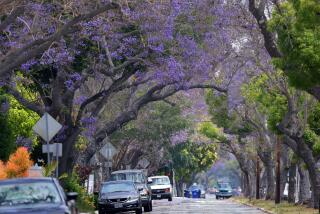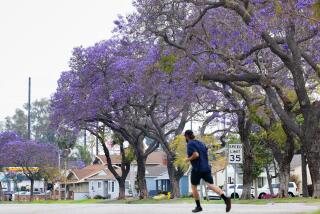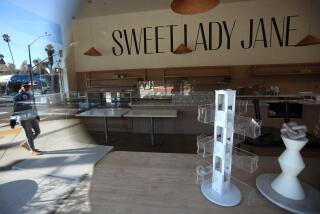Market Watch: New cherry varieties worth a pit stop
ARVIN, Calif. — — Early cherries are reason enough to head to the farmers market, but be careful. Erratic winter chill, freezes during bloom, hail and late rains have made for a short crop of early cherries from the southern San Joaquin Valley. But there’s still plenty of great fruit available at farmers markets for those who take care to select fresh, ripe cherries of the best varieties. In the last decade, the task has become trickier, but potentially more rewarding, with the arrival of new and unfamiliar varieties.
Bing doesn’t grow well in the southern San Joaquin Valley, so Brooks, which is early, large, firm and highly flavored, is the standard of quality there. This cross of Rainier and Burlat, introduced in 1988 by the University of California, is so good at its best that some growers rush the harvest by picking them red or even pink, when they’re just passable; it’s therefore worth paying a premium to “cherry pick” the ripest fruits.
Avoid Tulare cherries unless they’re tip-top. Brooks cracks when it rains, so many farmers grow the crack-resistant Tulare, a second-generation seedling of Bing introduced in 1988 by Bradford Genetics (now B.Q. Genetics). Until it’s fully ripe, it has a little point at the bottom that helps water to drain off. Growers often say, “Tulare is pretty good if it’s really ripe,” which is true, but its flavor is more often mediocre. It’s worth sampling, and buying if it’s good, but there are better early varieties available.
The new standard for early cherries is Sequoia, a marketing name for three similar proprietary (privately controlled) varieties, of which the most important is Glenred, a hybrid of Brooks and Tulare introduced in 2000. It combines the flavor and firmness of Brooks with the rain-resistance of Tulare and often sets a crop when other varieties don’t. The rights to grow and market Sequoias are controlled by Warmerdam Packing, which allows only one grower, Murray Family Farms of Arvin, to sell at farmers markets. Their Sequoia harvest is winding down, but late-picked fruits are darkest and deepest in flavor, so if they have any in the next week, grab them.
Murray, which grows 30 cherry varieties on 180 acres in the extreme southeastern corner of the San Joaquin Valley, offers a range of excellent (and some less good) varieties over its seven-week season and, conveniently for shoppers, makes a point of identifying them. This year it’s got half of a full crop, much better than its neighbors, some of whom didn’t have any fruit to pick. Murray sells in Santa Monica on Wednesdays, Woodland Hills and Redlands on Thursdays, Torrance and Ventura on Saturdays, and Hollywood, Santa Clarita and Ojai on Sundays.
Murray will have two lesser-known but superb new varieties this week, Flavor Giant and GG-100, both of them firm, dark fruits with high sugar, balancing acidity and intense flavor. Flavor Giant is small in size but big in flavor, with skin and flesh that can be almost black when fully ripe. Introduced as a pollenizer for Tulare, it never became a commercial success because of its size, but its rich, vinous flavor makes it a favorite among discerning buyers at farmers markets.
GG-100, which came out of the same program that bred Brooks, follows it in season. Like Flavor Giant it serves chiefly as a pollenizer in commercial orchards, but the fruit is large, with dark flesh and skin, and a pop on the palate, from high acidity and high sugar, that makes it suitable for both fresh eating and cooking.
Another good choice is Coral Champagne, also an alumnus of the Brooks program, which has been widely planted in recent years because it’s highly productive for farmers; its flavor is good but not quite as intense as Flavor Giant and GG-100.
Currently Murray also has Royal Rainier, a second-generation seedling of Stella patented by Zaiger Genetics in 1999. It is not directly related to the standard Rainier (Bing x Van, 1960), but it’s similar in appearance, with gold skin and a pink blush. You can tell the difference because Royal Rainier has a longer, thinner stem. The fruit tends to be tart, slightly astringent and flavorless until it’s dead-ripe, but at that point it’s a honeyed treat.
California farmers grow about 42,000 acres of cherries, of which 7,000, plus 1,800 of young, nonbearing trees, are in Kern County, the southernmost commercial cherry district; 7,000 more are grown in the middle San Joaquin Valley, in Fresno, Tulare and Kings counties, where the season is just entering full swing.
The biggest growing area by far, with about 25,000 acres, is the area around Stockton, Linden and Lodi, where the Bing is still king. The Bing harvest from this area, which looks to be a good one, will start this coming week or the next one for most growers. J. P. Barbagelata will have Bings at the Santa Monica market on Wednesday, May 30. Only a limited number of actual farmers or their employees are willing to drive 700 miles round-trip to sell at Southern California farmers markets, but when properly dark, the Bing is unbeatable.
For commercial growers, planting late varieties in an early area might seem as anomalous as breeding miniature giraffes, but it makes sense for farmers market vendors to extend their season. Lapins, Sweetheart and Skeena, three leading late-season varieties that mature in late July and August in the Northwest, start ripening in early June in the southern San Joaquin Valley. Skeena is the firmest, darkest and best of those three, at least in this area.
For all cherries, if a stand is selling mostly spurs and doubles (malformed fruits), walk away unless they’re heavily discounted; they may be cheap culls that an unscrupulous vendor has bought from neighbors or packinghouses.
More to Read
Eat your way across L.A.
Get our weekly Tasting Notes newsletter for reviews, news and more.
You may occasionally receive promotional content from the Los Angeles Times.










